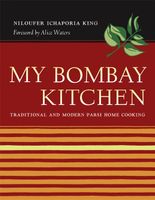Advertisement
Three Generations of Kitchen Equipment
Appears in
Published 2007
This is an approximation of what my grandmother needed to feed her family of five daughters, plus her sister and her three children, not to mention a large household staff.
- A cook, known and addressed as mistri (cooks in Parsi households were mostly Goan).
- A cook’s helper, sometimes known as the matey, a British nautical term.
- A bearer or butler in a starched white uniform for serving. Extra bearers for large parties.
- A wood- or charcoal-burning cast-iron range with an oven and, later, a gas stove, the gas piped in by the city.
- A sigri, a portable cylindrical grill about 18 inches high, for grilling or for an extra heat source.
- A kerosene stove (for emergencies or an extra heat source).
- Tinned copper vessels, deep, with lids like dinner plates to hold water or coals. Tinning was and still is done by wandering kalai wallas, tinsmiths, who can set up shop in a three-foot-square space with a fire, bellows, and some tin.
- Straight-sided shallow tinned copper vessels with flat lids, no handles.
- Khumchas, circular trays with straight sides for working dough and other uses. Made of tinned copper or German silver.
- Various tongs for lifting lids or turning chapatis; perforated spoons, usually metal.
- A cast-iron lohri or tava, a lens-shaped griddle about a foot across, for cooking chapatis or dry-roasting anything.
- Frying pans like woks, karhais, in sizes geared to the household (made of cast iron, tinned copper, or possibly aluminum, in diameters ranging from 8 to 16 inches).
- A grinding stone, masala no patthar—slab and roller, the surface to be roughened from time to time by an itinerant worker, the tankiwali, who would go from house to house announcing her presence.
- A large domed aluminum steamer (on the bottom, Queen Mary in profile) for a sweet called sandhna.
- A mortar and pestle, made of heavy brass.
- Knives to suit the cooks.
- A rotary eggbeater (although egg whites and cream could be whipped up with a fork in a soup plate, too).
- Miscellaneous work bowls and plates, molds for desserts, baking dishes.
- Large Chinese storage urns for grains; brass canisters and boxes for storing other staples.
- An icebox, later a refrigerator.
- A perforated vessel for cheesemaking.
- Strainers and colanders of various sizes.
- A dal masher made of wood.
- A slender wooden rolling pin and circular board for rolling out chapatis and puris.
- A hand-cranked meat grinder.
- A household balance and various weights and measures for grains and liquids: these would be in various systems, Indian and imperial.

